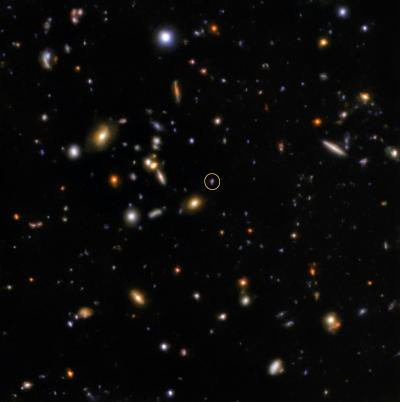Jul 15 2020
Using two Maunakea Observatories based in Hawaii, astronomers have successfully detected a short gamma-ray burst (SGRB)—the second-most distant and confirmed explosion—to be ever studied, to date.
 The afterglow of grb181123b, captured by the Gemini North telescope. The afterglow is marked with a circle. Image Credit: International Gemini Observatory/NOIRLab/NSF/AURA/K. Paterson and W. Fong (Northwestern University) Image processing: Travis Rector (University of Alaska Anchorage), Mahdi Zamani, and Davide de Martin.
The afterglow of grb181123b, captured by the Gemini North telescope. The afterglow is marked with a circle. Image Credit: International Gemini Observatory/NOIRLab/NSF/AURA/K. Paterson and W. Fong (Northwestern University) Image processing: Travis Rector (University of Alaska Anchorage), Mahdi Zamani, and Davide de Martin.
The two observatories are W. M. Keck Observatory and the international Gemini Observatory—a Program of NSF’s NOIRLab.
Telescopic observations revealed that the object is located 10 billion light-years away, placing it directly in the era of cosmic high noon when the universe was quickly forming stars and was in its “teenage years.”
Theories about the origins of the SGRBs could be altered by their emergence at such an early time, especially theories about the duration of time taken by a pair of neutron stars to combine and create these strong bursts, and also the merging rate of neutron stars in the young universe.
This was a very exciting object to study. Our research now suggests neutron star mergers could occur surprisingly quickly for some systems—with neutron star binaries spiraling together in less than a billion years to create an SGRB.
Kerry Paterson, Study Lead Author and Postdoctoral Associate, Center for Interdisciplinary Exploration and Research in Astrophysics, Northwestern University
The study is available in preprint format on arXiv.org and has been accepted in The Astrophysical Journal Letters.
SGRBs can be described as highly energetic, short-lived explosions of gamma-ray light. While the gamma-ray light exists for less than 2 seconds, the optical light can last for several hours and then fades away. Hence, the optical afterglow of these strong bursts of gamma-ray radiation should be rapidly monitored.
Within a few hours after the Neil Gehrels Swift Observatory of NASA identified the object and announced a global alert, Paterson’s research team immediately pointed the Keck I and Gemini North telescopes toward the site of the SGRB.
The scientists first used the Gemini Multi-Object Spectrograph and then employed Keck Observatory’s Multi-Object Spectrograph for Infrared Exploration (MOSFIRE) instrument, and effectively quantified the extremely faint afterglow of the object. This object is called GRB181123B, since it was the second explosion to be identified on November 23rd, 2018—the Thanksgiving night, to be precise.
It was unreal. I was in New York with my family and had finished having a big Thanksgiving dinner. Just as I had gone to sleep, the alert went off and woke me up. While somewhat of a nuisance, you literally never know when you’ll land a big discovery like this! I immediately triggered the Gemini observations and notified Kerry.
Wen-fai Fong, Study Co-Author and Assistant Professor, Department of Physics and Astronomy, Northwestern University
Fong continued, “Thankfully, she happened to be observing at Keck that night and was able to rearrange her original observing plan and repoint the telescope towards the SGRB.”
“It was such an adrenaline-rush to be at Keck when the SGRB alert went off and personally move the telescope towards the object to capture data mere hours after the burst,” Paterson added.
SGRBs that are accurately localized are quite rare, and most often only 7 to 8 of these explosions are identified every year. To locate the distance of the GRB181123B object, the researchers used Keck Observatory’s DEep Imaging as well as Multi-Object Spectrograph (DEIMOS) to acquire spectra of its host galaxy via follow-up observations.
Once we obtained the optical spectrum from DEIMOS, it was clear this event was one of the most distant SGRBs measured, which further fueled our investigation to determine its precise distance.
Kerry Paterson, Study Lead Author and Postdoctoral Associate, Center for Interdisciplinary Exploration and Research in Astrophysics, Northwestern University
This allowed the researchers to obtain more observations with Keck Observatory, together with the Multi-Mirror Telescope based in Arizona and the Gemini South telescope based in Chile. With a distance estimated at a cosmological redshift of 1.754 and based on the data obtained, the object was confirmed to be the most distant, high-confidence SGRB with an optical afterglow detection to be ever discovered to date.
“The identification of certain patterns in the spectrum, together with the colors of the galaxy from the three observatories, allowed us to precisely constrain the distance and solidify it as one of the most distant SGRBs to date in 16 years of Swift operations,” Paterson added.
Once the researchers detected the host galaxy, they successfully established the crucial characteristics of the parent stellar population inside the galaxy that created the SGRB.
“Performing ‘forensics’ to understand the local environment of SGRBs and what their home galaxies look like can tell us a lot about the underlying physics of these systems, such as how SGRB progenitors form and how long it takes for them to merge,” Fong added.
“We certainly did not expect to discover an extremely distant SGRB, as they are very rare and faint, but we were pleasantly surprised! This motivates us to go after every one that we possibly can,” concluded Fong.